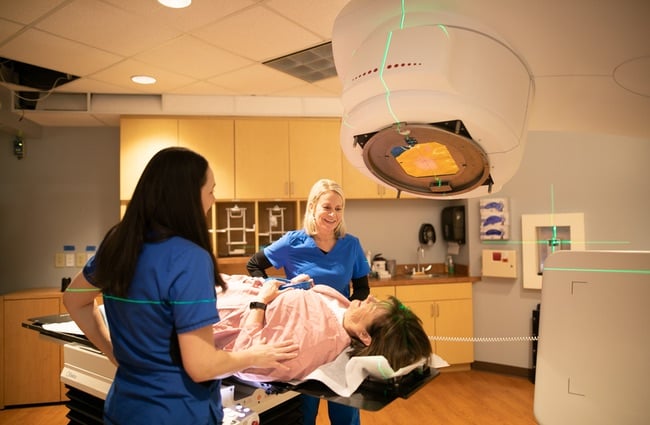
The use of high-energy rays to destroy cancer cells is called radiation therapy or radiotherapy. Radiation therapy is one of several categories of therapy used to treat breast cancer. Radiation therapy is often combined with surgery, chemotherapy, targeted therapy, hormone therapy and in some cases, immunotherapy, to ensure the best possible outcome. While the combination of breast cancer treatments varies by patient, it’s very common for patients to receive radiation therapy before and/or after surgery.
How is Radiation Therapy Used?
Radiation therapy kills or slows down the growth of cancer cells. For breast cancer patients it’s used to be sure that any left over breast cancer cells that could be left after surgery are killed in the breast and in nearby lymph nodes.
The high-energy rays can destroy some of the healthy cells. The radiation oncologist protects the healthy cells through the below steps.
- The lowest possible dose of radiation is always administered.
- Radiation treatments are spread out over time.
- Radiation is directed towards a specific part of the body.
Types of Radiation Therapy for Breast Cancer
Radiation therapy for breast cancer is most commonly external beam radiation. Internal radiation called breast high-dose rate brachytherapy can be an option for patients whose breast cancer was found at a very early stage and meet specific criteria.
External Beam Radiation
This type of radiation therapy uses a linear accelerator to send radiation beams to the affected part of the breast. The radiation is delivered at various angles to be sure it’s reaching the area where the cancer was located in the breast.
- If you have had breast-conserving surgery, you will likely receive radiation to the entire breast.
- If cancer was found in your lymph nodes, radiation may be given to the lymph nodes under your arms, above your collarbone, and/or beneath your breastbone.
- If you have had a mastectomy, the radiation will be focused on your chest wall, your mastectomy scar, and anywhere you received drains following your surgery.
Internal Radiation
Internal radiation is also called brachytherapy. For breast cancer it’s called high-dose rate (HDR) brachytherapy. Used most often for women whose cancer was found at a very early stage, this method uses small tubes or catheters with radioactive pellets placed inside the breast near the affected breast tissues. Your radiation oncologist will talk with you about what is right for your specific situation.
The goal of this form of radiation is to reduce the risk of breast cancer recurrence. It also limits the dose of radiation to surrounding normal tissue.
While internal radiation therapy is an effective way to deliver treatment to an exact area, it may not be appropriate for all breast cancer patients. Factors including tumor location and size may limit whether you are able to receive this treatment.
The American Brachytherapy Society recommends internal radiation therapy to women over the age of 45 following a lumpectomy if:
- The removed tumor is three centimeters or smaller in size
- The cancer has not spread to the lymph nodes
- No cancer cells were found in the rim of healthy tissue removed with the cancer
Related blog: Internal vs External Radiation for Breast Cancer: How Do These Treatments Compare?
When Do Oncologists Recommend Radiation Therapy?
Radiation therapy is a suitable breast cancer treatment in more than one instance. However, radiation therapy is not the ideal choice if you are pregnant or have scleroderma. Scleroderma is a connective tissue disease that makes you too sensitive for radiation therapy.
Radiation Therapy After Breast-Conserving Surgery
Breast-conserving surgery or lumpectomy is the removal of the breast cancer tumor rather than the entire breast. Oncologists recommend lumpectomy when cancer has not spread to the other parts. Lumpectomy is followed by radiation therapy to destroy the remaining cancer cells.
Radiation therapy lowers the risk of cancer recurrence.
Radiation Therapy After Mastectomy
During a mastectomy, oncologists may not be able to remove all the cancer cells from the breast tissues. Radiation therapy is used after surgery to ensure no cancer cells are left behind. The energy beams are focused towards the area. And in some cases, the nearby lymph nodes are also included.
Radiation therapy after mastectomy is preferred under the following circumstances:
- The size of the tumor is over 5 centimeters
- The margins from the affected area are positive
- Cancer has reached the lymph nodes
Radiotherapy can also be used to relieve side-effects when cancer has reached other parts of the body.
What Happens During Radiation Therapy?
Before the external beam radiation treatment, your radiation oncologist conducts a physical examination. A planning or non-diagnostic CT scan follows the exam. The scan images will help the oncologist to locate the precise areas where radiation therapy will need to be targeted.
Your body may be marked with a permanent marker or a tattoo. These marks will ensure that beams are pointing to the correct location during each treatment. Additionally, a simulation treatment will be conducted where there is no actual treatment administered. You will lay on the table and the oncologist will be sure that everything is precisely aligned as directed by your treatment plan.
How Long Does Breast Cancer Radiation Therapy Take?
Each session of radiotherapy lasts about 15 minutes or less once you’ve been placed in the exact position you need to be in. For many patients, radiation therapy is started a few weeks after breast cancer removal surgery. Generally, radiation therapy is recommended five days a week for 4 to 8 weeks, based on how your body responds.
In the case of internal radiation, a catheter is placed at the lumpectomy side. The device remains in place until the end of the treatment that should take a week or less. A radioactive pellet is placed inside the catheter during the treatment session and allowed to stay for about 10 minutes. In internal radiation, oncologists recommend two treatment sessions for five days. The treatment plan may change based on the biology of your tumor.
What Are the Side-Effects of Radiation Therapy?
Short-term side-effects of external beam radiation therapy are:
- Fatigue
- The skin from the treated area experiences redness, peeling, and color changes
- The breast swells and causes a feeling of heaviness
- The treated area becomes itchy and tender
- Changes to the skin and breast tissue subside within a few months.
Long-term side-effects of external beam radiation therapy are:
- Radiation therapy may make the treated breast smaller and firmer if breast conserving surgery was performed.
- Radiation therapy can cause a condition called brachial plexopathy. The condition is a result of damage to some of the nerves around the arm. It is characterized by pain, numbness, weakness around the shoulder and arm.
- Radiation therapy may impact breast reconstruction options.
- Breastfeeding could be difficult
Internal radiation has fewer side-effects than external beam radiation. After the internal radiation therapy, most patients experience breast pain, redness around the affected area, and fatty tissue damage.
Related blog: Dealing With Breast Cancer Treatment Side Effects
Can You Control the Side-Effects of Radiation Therapy?
Fortunately, your radiation oncologist can suggest various ways to keep your radiation therapy side-effects under control.
Some of them are:
- Avoid direct exposure to sunlight.
- Use skin products that your doctor recommends to protect your skin.
- Wear clothes that are loose and feel comfortable on your skin.
- Stay hydrated and get enough rest to combat fatigue.
- Eat a well-balanced diet.
If you or someone you know has been recently diagnosed with breast cancer, our team is here to help. To learn more about breast cancer radiation therapy and the benefit of an individualized cancer treatment plan, give us a call today to schedule an appointment at one of our five locations in Georgia. Our locations are conveniently located throughout the Atlanta metro area including Decatur, Conyers, Covington, and Snellville.
Update: November 2023




